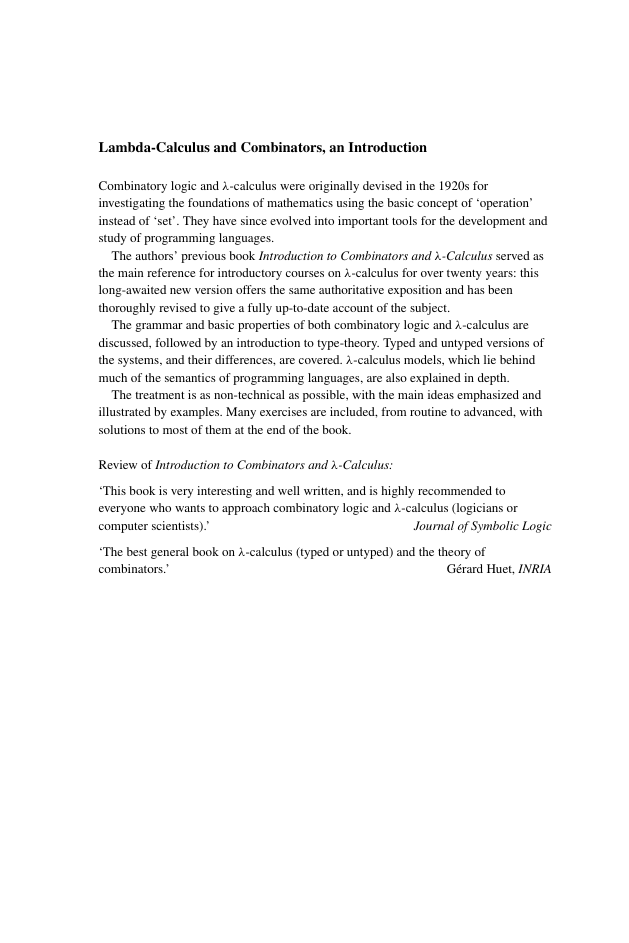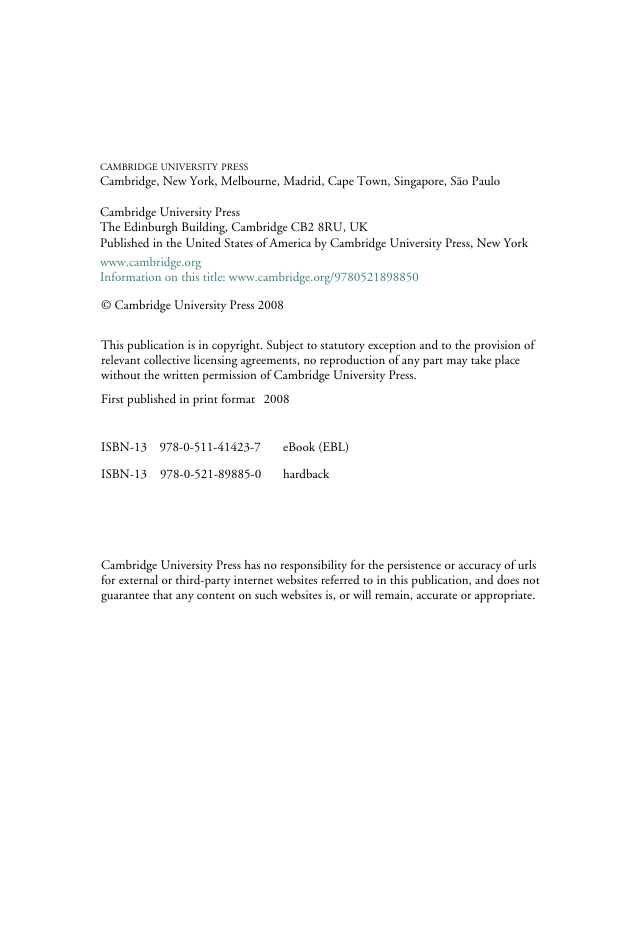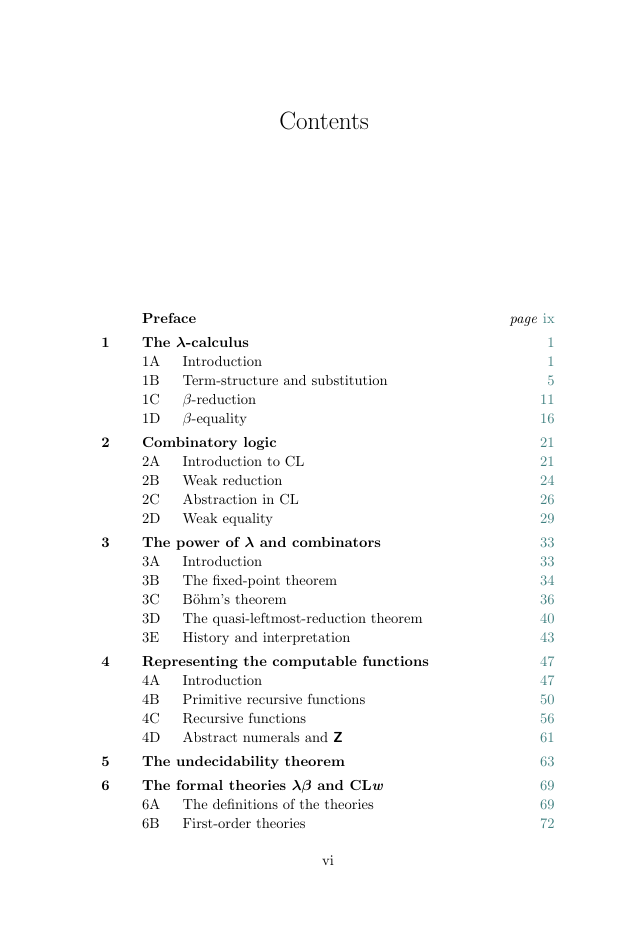Cover
Half-title
Title
Copyright
Contents
Preface
1 The lambda-calculus
1A Introduction
1B Term-structure and substitution
1C beta-reduction
1D beta-equality
Further reading
2 Combinatory logic
2A Introduction to CL
2B Weak reduction
2C Abstraction in CL
2D Weak equality
Further reading
3 The power of lambda and combinators
3A Introduction
3B The fixed-point theorem
3C Bohm’s theorem
3D The quasi-leftmost-reduction theorem
3E History and interpretation
4 Representing the computable functions
4A Introduction
4B Primitive recursive functions
4C Recursive functions
4D Abstract numerals and Z
5 The undecidability theorem
6 The formal theories lamnda beta and CLw
6A The definitions of the theories
6B First-order theories
6C Equivalence of theories
7 Extensionality in lambda-calculus
7A Extensional equality
7B lambdaeta-reduction in lambda-calculus
8 Extensionality in combinatory logic
8A Extensional equality
8B Axioms for extensionality in CL
8C Strong reduction
9 Correspondence between lambda and CL
9A Introduction
9B The extensional equalities
9C New abstraction algorithms in CL
9D Combinatory beta-equality
10 Simple typing, Church-style
10A Simple types
10B Typed lambda-calculus
10C Typed CL
11 Simple typing, Curry-style in CL
11A Introduction
11B The system TA→C
11C Subject-construction
11D Abstraction
11E Subject-reduction
11F Typable CL-terms
11G Link with Church’s approach
11H Principal types
11I Adding new axioms
11J Propositions-as-types and normalization
12 Simple typing, Curry-style in lambda
12A The system TA→lambda
12B Basic properties of TA→lambda
12C Typable lambda-terms
12D Propositions-as-types and normalization
12E The equality-rule Eq
Further reading
13 Generalizations of typing
13A Introduction
13B Dependent function types, introduction
13C Basic generalized typing, Curry-style in lambda
13D Deductive rules to define types
13E Church-style typing in lambda
13F Normalization in PTSs
13G Propositions-as-types
13H PTSs with equality
14 Models of CL
14A Applicative structures
14B Combinatory algebras
15 Models of lambda-calculus
15A The definition of lambda-model
15B Syntax-free definitions
15C General properties of lambda-models
16 Scott's D∞ and other models
16A Introduction: complete partial orders
16B Continuous functions
16C The construction of D∞
16E D∞ is a lambda-model
16F Some other models
Further reading
Appendix A1 Bound variables and alpha-conversion
Appendix A2 Confluence proofs
A2A Confluence of beta-reduction
A2B Confluence of other reductions
Appendix A3 Strong normalization proofs
A3A Simply typed lambda-calculus
A3B Simply typed CL
A3C Arithmetical system
Appendix A4 Care of your pet combinator
Appendix A5 Answers to starred exercises
References
List of symbols
Index
















 2023年江西萍乡中考道德与法治真题及答案.doc
2023年江西萍乡中考道德与法治真题及答案.doc 2012年重庆南川中考生物真题及答案.doc
2012年重庆南川中考生物真题及答案.doc 2013年江西师范大学地理学综合及文艺理论基础考研真题.doc
2013年江西师范大学地理学综合及文艺理论基础考研真题.doc 2020年四川甘孜小升初语文真题及答案I卷.doc
2020年四川甘孜小升初语文真题及答案I卷.doc 2020年注册岩土工程师专业基础考试真题及答案.doc
2020年注册岩土工程师专业基础考试真题及答案.doc 2023-2024学年福建省厦门市九年级上学期数学月考试题及答案.doc
2023-2024学年福建省厦门市九年级上学期数学月考试题及答案.doc 2021-2022学年辽宁省沈阳市大东区九年级上学期语文期末试题及答案.doc
2021-2022学年辽宁省沈阳市大东区九年级上学期语文期末试题及答案.doc 2022-2023学年北京东城区初三第一学期物理期末试卷及答案.doc
2022-2023学年北京东城区初三第一学期物理期末试卷及答案.doc 2018上半年江西教师资格初中地理学科知识与教学能力真题及答案.doc
2018上半年江西教师资格初中地理学科知识与教学能力真题及答案.doc 2012年河北国家公务员申论考试真题及答案-省级.doc
2012年河北国家公务员申论考试真题及答案-省级.doc 2020-2021学年江苏省扬州市江都区邵樊片九年级上学期数学第一次质量检测试题及答案.doc
2020-2021学年江苏省扬州市江都区邵樊片九年级上学期数学第一次质量检测试题及答案.doc 2022下半年黑龙江教师资格证中学综合素质真题及答案.doc
2022下半年黑龙江教师资格证中学综合素质真题及答案.doc